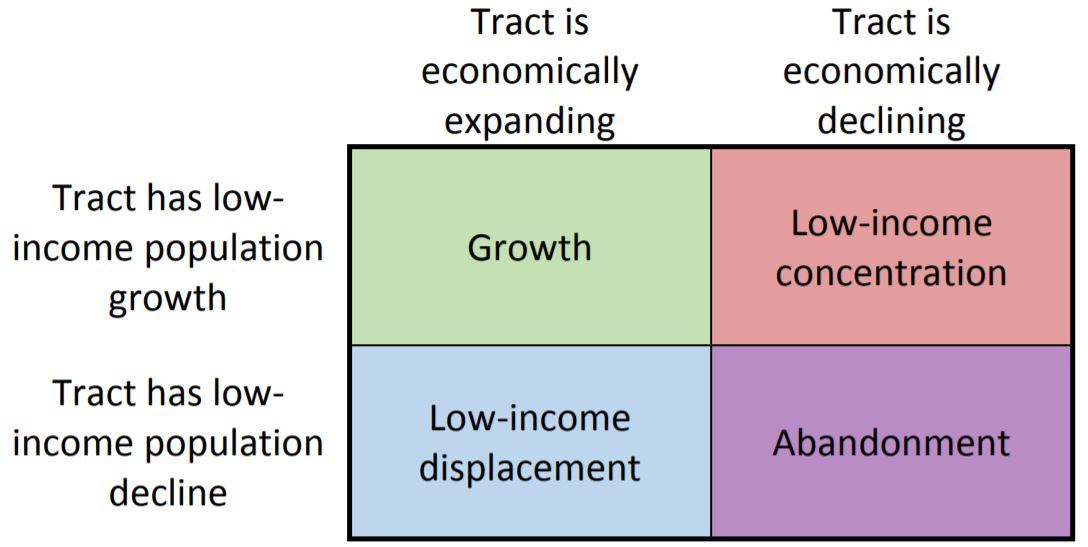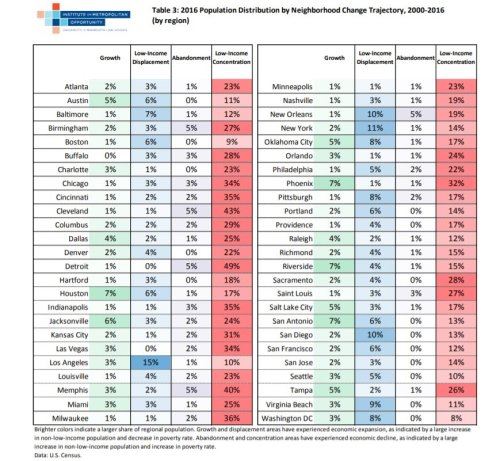A new report - American Neighborhood Change in the 21st Century: Gentrification and Decline - from the Institute on Metropolitan Opportunity at the University of Minnesota Law School captures growth, low-income displacement, low-income concentration, and abandonment from 2000-2016 at the census tract level and depicts aggregated population and housing change in two categories of neighborhoods:
- Economically expanding neighborhoods, which are those experiencing the kind of population changes associated with growth and displacement (gentrification). These are neighborhoods where the low-income share of the population has fallen since 2000 (indicating the area has grown less poor overall) and the absolute number of non-low-income residents has grown since 2000 (indicating that middle-income residents see the area as an attractive place to live).
- Economically declining neighborhoods, which are those experiencing the kind of population changes associated with abandonment and poverty concentration. These are neighborhoods where the low-income share of the population has grown since 2000 (indicating that an area has grown poorer overall) and the absolute number of non-low-income residents has fallen since 2000 (indicating that middle-income residents do not see the area as an attractive place to live).

The report finds that:
- The most common form of American neighborhood change, by far, is poverty concentration. About 36.5 million residents live in a tract that has undergone low-income concentration since 2000.
- At the metropolitan level, low-income residents are invariably exposed to neighborhood decline more than gentrification. As of 2016, there was no metropolitan region in the nation where a low-income person was more likely to live in an economically expanding neighborhood than an economically declining neighborhood.
- Low-income displacement is the predominant trend in a limited set of central cities, primarily located on the eastern and western coasts. Los Angeles and Washington, D.C. have the most widespread displacement.
- On net, far fewer low-income residents are affected by displacement than concentration. Since 2000, the low-income population of economically expanding areas has fallen by 464,000, while the low-income population of economically declining areas has grown 5,369,000.
- White flight corresponds strongly with neighborhood change. Between 2000 and 2016, the white population of economically expanding areas grew by 44 percent. In declining areas, white population fell by 22 percent over the same span.
- Nonwhite residents are far more likely to live in economically declining areas. In 2016, nearly 35 percent of black residents lived in economically declining areas, while 9 percent lived in economically expanding areas.
Click here to access the interactive map.
The report also includes details about metro-level neighborhood change about the nation’s 50 largest metropolitan areas. Indianapolis ranks 45th of the nation’s 50 largest metro areas in terms of the spread of concentrated poverty and abandonment.

The report’s summary for Indianapolis says:
“Gentrification is effectively nonexistent in the Indianapolis metropolitan area, while the region – and especially the city of Indianapolis itself – suffers from widespread and ongoing poverty concentration and neighborhood abandonment.
“About 57 percent of Indianapolis city residents live in strongly declining neighborhoods, as do about 72 percent of low-income residents (defined in this report as those below 200 percent of the federal poverty line). While the overall population of these areas has fallen modestly since 2000 – about 4 percent – the low-income population has grown over 50 percent. These changes have been accompanied by racial change, as the black and Hispanic population of those neighborhoods has grown by 49,000, and the white population has dropped by nearly 80,000, indicating significant white flight.”
Click here to read the full summary for Indianapolis.

